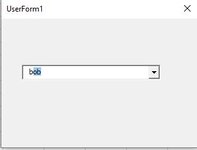Hi everyone,
i have 80000 rows in "c"column with date in it. i am running below mentioned code to add the combobox list items on combobox change basis. When i run the macro it takes too long time on each change.
Can anybody suggest what to do to speed up the code.
Private Sub ComboBox2_Change()
Dim ws As Worksheet
Set ws = Worksheets("word by word")
Dim Lastrow, r, i As Long
For i = ComboBox2.ListCount - 1 To 0 Step -1
ComboBox2.RemoveItem i
Next i
Lastrow = ws.Range("c" & Rows.Count).End(xlUp).Row
For r = 3 To Lastrow
If InStr(ws.Cells(r, 3), ComboBox2.Text) > 0 Then
ComboBox2.AddItem (ws.Range("c" & r))
'code for showing list unique values only
Dim vArr()
ReDim vArr(1 To ComboBox2.ListCount)
vArr = ComboBox2.List
Dim e
With CreateObject("scripting.dictionary")
.comparemode = 1
For Each e In vArr
If Not .exists(e) Then .Add e, Nothing
Next
If .Count Then ComboBox2.List = (.keys)
End With
End If
If ComboBox2.Text = "" Then
ComboBox2.Clear
End If
Next r
End Sub
i have 80000 rows in "c"column with date in it. i am running below mentioned code to add the combobox list items on combobox change basis. When i run the macro it takes too long time on each change.
Can anybody suggest what to do to speed up the code.
Private Sub ComboBox2_Change()
Dim ws As Worksheet
Set ws = Worksheets("word by word")
Dim Lastrow, r, i As Long
For i = ComboBox2.ListCount - 1 To 0 Step -1
ComboBox2.RemoveItem i
Next i
Lastrow = ws.Range("c" & Rows.Count).End(xlUp).Row
For r = 3 To Lastrow
If InStr(ws.Cells(r, 3), ComboBox2.Text) > 0 Then
ComboBox2.AddItem (ws.Range("c" & r))
'code for showing list unique values only
Dim vArr()
ReDim vArr(1 To ComboBox2.ListCount)
vArr = ComboBox2.List
Dim e
With CreateObject("scripting.dictionary")
.comparemode = 1
For Each e In vArr
If Not .exists(e) Then .Add e, Nothing
Next
If .Count Then ComboBox2.List = (.keys)
End With
End If
If ComboBox2.Text = "" Then
ComboBox2.Clear
End If
Next r
End Sub







